

Finland used a lot of captured Soviet equipment during the Second World War; among this were a number of Soviet fighters. These fell in Finnish hands during the Winter War and the Continuation War and was repaired and used against the former owner. Among the captured fighters were a number of Polikarpov I-152 and I-153 fighters.
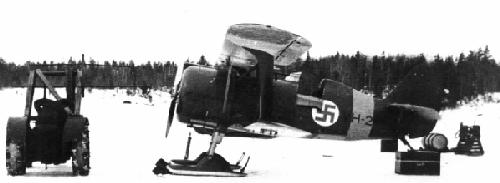
During the Winter War the Finns captured five I-152s after they made forced landings on Finnish soil. Two of the five reached Lentolaivue (LLv) 29, the replenishment and training squadron of the Finnish Air Force. After the cease-fire, the rest of the aircraft were delivered to serve as fighter-trainers in LLv 34 After LLv 29 was disbanded, its aircraft were also handed over to LLv 34.
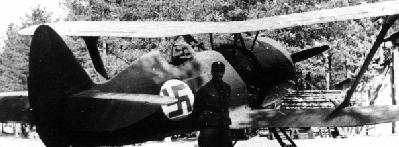
Early in the Continuation War, LLv 34 was dissolved and the I-152s were assigned as trainers to the Täydennyslentolaivue 35 (a replenishment squadron) and two of the aircraft were placed in storage during late 1942. In mid-1943, three aircraft were transferred to the re-established LeLv 34 as target-tows. In 1944 two of the aircraft served in T-LeLv 35. After the war, the aircraft were placed in storage at the air force depot.
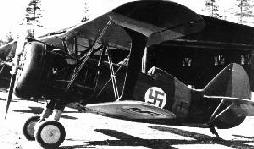
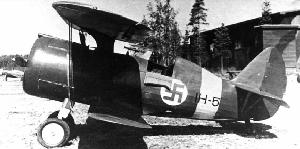
The last flight of the I-152s in Finnish Air Force service was on 12 March 1945 when IH-4 and IH-5 were flown to the depot.
The first two Finnish I-152s initially carried the registration numbers VH-10 and VH-11, while the remaining three biplanes were given serials VH-3 to VH-5. During late 1940, VH-10 and VH-11 were renumbered as VH-1 and VH-2. On 4 June 1942, the confusion regarding the numbering of war booty aircraft was resolved and the aircraft were given the serials IH-1 to IH-5.
Polikarpov I-152s in Finnish service
| Serial number | Squadron use | Notes | Stored in depot | Total flying time |
| VH10 - VH-1 - IH-1 | 23/02/40 LLv 29 17/03/41 LLv 34 08/09/41 2/T-LLv 35 |
Winter War booty aircraft. 20/03/40 Skis went through snow in landing at Parola, the aircraft turning upside down. Vänrikki H. Sundberg injured. Late 1940 Renumbered to VH-1 to prevent overlapping with captured I-153s whose serials began with VH-12. 04/06/42 Renumbered to IH-1. Autumn 1942 Stored as worn out. |
11/09/42 | 109,05 hours |
| VH11 - VH-2 - IH-2 | 26/02/40 LLv 29 01/04/40 T-LLv 35 19/09/40 LLv 34 17/10/41 2/T-LLv 35 15/07/43 LeLv 34 |
Winter War booty aircraft. Ex Yellow 173 of the Soviet Air Force. 19/03/40 Overshot the landing at Parola. Late 1940 Renumbered to VH-2 to prevent overlapping with captured I-153s whose serials began with VH-12. 04/06/42 Renumbered to IH-2. Crashed when curving at Vesivehmaa. Delivered after repairs to LeLv 34 on 15/07/43. Used as target-tug. 02/08/43 Crashed when landing at Kymi. |
20/02/45 | 114,50 hours |
| VH-3 - IH-3 | 19/09/40 LLv 34 08/09/41 2/T-LLv 35 15/07/43 LeLv 34 02/10/43 LeLv 30 04/02/44 2/T-LeLv 35 |
Winter War booty aircraft. After repairs at the State Aircraft Factory delivered to 2/T-LLv 35 on 08/09/41. 19/11/41 A propeller blade broke at take-off at Vesivehmaa. 04/06/42 Renumbered to IH-3. Used as target-tug. |
20/02/45 | 115,25 hours |
| VH-4 - IH-4 | 11/10/40 LLv 34 04/02/42 2/T-LLv 35 07/08/43 LeLv 34 19/09/43 LeLv 30 04/02/44 2/T-LeLv 35 |
Winter War booty aircraft. 17/10/40 Crash-landed at Parola. 20/06/41 Stall-landing at Parola and crashing due to undercarriage failure. The pilot luutnantti J. Ihatsu was injured. 04/06/42 Renumbered to IH-4. Used as target-tug. 42-43 Swung to the right when landing at Vesivehmaa and overturned when hitting sandy soil. Vänrikki V. Reponen escaped uninjured. |
12/03/45 | 144,25 hours |
| VH-5 - IH-5 | 03/02/41 LLv 34 10/04/41 Er.LLv 03/12/41 2/T-LLv 35 |
Winter War booty aircraft. 09/06/41 Swung to the left when landing at Turku and overturned. Pilot luutnantti V. Virtanen escaped uninjured. 04/06/42 Renumbered to IH-4. Autumn 1942 Stored as worn out. |
11/09/42 | 106,55 hours |
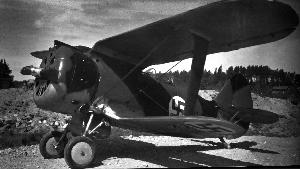
During the Winter War, eight I-153 aircraft were captured after they force landed in Finland. The first I-153 was given the registration VH-101 and was ready on 18 April 1940. It was delivered to LeLv 14. The others received the numbers VH-12 to VH-18.
During the early stage of the Continuation War, three additional I-153s were captured, receiving the registrations VH-19 to VH-21. On 4 June 1942, the prefix was changed from VH to IT.
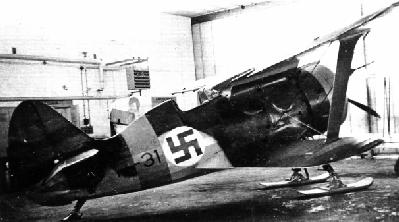
An additional nine I-153s were purchased from Germany on 18 November 1942. These aircraft, all painted overall Light Gray, were handed over to the Finnish Air Force at Vienna, Austria on 7 December 1942. During the ferry flight to Finland, three were damaged and arrived later. Another aircraft was handed over on 27 August 1943. These new I-153s were numbered IT-22 to IT-31. A total of twenty-one I-153s was taken into the inventory of the Finnish air arm.
In Finnish service the I-153 was re-armed, having four 7.70mm Browning M.39 machine guns, in place of the original Soviet ShKAS 7.62mm guns. In addition, a BBC.AAK-1 gunsight replaced the original Soviet PAK-1 gunsight.
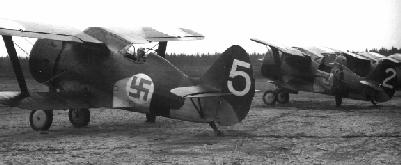
On 21 June 1941 just before the start of the Continuation War the I-153s were assigned to Lentolaivue 6 (LLv 6). This squadron was assigned to the Naval Headquarters for patrol, anti-submarine operations, and attacking Soviet ground troops. LLv 6 under the command of majuri K. Ilanko included a bomber flight with captured SB-2s and a fighter flight (the 3rd Flight) with I-153s. The 3rd Flight was under the command of kapteeni L. Karjalainen and was based at Turku with five operational aircraft.
On 25 June, the Soviet Air Force attacked Turku in three waves of 40 aircraft. The Finnish fighter didn't catch the attacker but the Continuation War had started.
In the first attack at around 06:00, 30 DB-3Ts and 54 SBs from 1 MTAP and 57 BAP VVS/KBF took part, escorted by 2 escadrlia from 13 IAP from Hanko.
Early in the morning on 26 June (between 03:00 and 04:05), 18 Soviet aircraft attacked Turku and the first attack was made by 9 SBs from the VVS/KBF. A patrol led by kapteeni Karjalainen took off and caught the SBs at 3,000 meters height. Lentomestari T. Hämelä (VH-14) caught up with the bombers at Korpoo, though he could get no closer than 200-300 meters as his landing gear would not retract. After firing short bursts for one minute, his victim started to smoke and according to ground observer at Pansio it dived into the sea. The remaining formation evaded into a cloud at 2,000 meters. All Russian aircraft fired all the time when an opportunity arose but the didn’t score any hits.
According to Soviet sources, all aircraft returned to base.
The Turku airport became none operational due to damages in the attack and the 3rd Flight moved to Nummela.
On 10 July, an I-153 and a MiG-3 attacked a patrol led by luutnantti V. Kallio (VH-14) in the Hanko area. In the ensuing dogfight, the Finnish leader was shot down and killed.
On 12 August majuri Ilanko was succeeded by majuri J. Moilanen as Squadron Commander of LLv 6.
The Soviet ace Vasilii Golubyev (39 victories) of 13 IAP-KBF claimed two Finnish I-153s on 24 October 1941 while flying a. I-16. On this day I-153 VH-19 of 3/LLv 6 was hit in a dogfight and hit a barn in the subsequent forced landing in Inkoo and was damaged. The pilot alikersantti K. Koskinen was uninjured.
On 1 November luutnantti Riemu Rauha Paltila was appointed to lead the 3rd Flight.
The day before a formation of Curtisses from LLv 32 had arrived to Nummela to destroy the Soviet aircraft in Hanko. In November, the Curtisses were responsible for the fighter-defence and the Tshaikas for the reconnaissance.
On 3 December, the Hanko area was found empty and the Curtisses returned to the Karelian Isthmus.
On 12 December, the 3rd Flight of LLv 6 moved to Malmi airport. At this time the Flight had three I-153s.
Kapteeni Per-Erik Ahonius took over command of the 3rd Flight on 30 December.
On 13 January 1942, the 3rd Flight moved to a field near Hamina. This field was made on the frozen sea in order to support the army in the seizing of the outer islands in the Gulf of Finland.
The 3rd Flight moved to the neighbourhood of Kotka to an ice-field base on 19 March.
The same day a patrol led by luutnantti Paltila sighted an MBR-2 flying-boat which had landed on the ice. This aircraft was shot alight.
The attack on Suursaari started on 27 March and the 3rd Flight made several bomb and machine-gun attacks on the Soviet stations during the next two days. The island was taken on 28 March.
On 3 April a company-strong group of Soviet infantry was sighted between the islands Tytärsaari and Lavansaari. It was attacked by a patrol from 3/LLv 6 led by luutnantti Riemu Paltila, which made six strafing passes.
On 4 April, luutnantti Riemu Paltilas Chaika swarm of 3/LLv 6 observed a large camp area on a reconnaissance mission to Lavansaari. The detachment made three passes causing great confusion with their strafing in the camp area.
On 23 April the 3rd Flight moved to Malmi airport.
On 27 May, the 3rd Flight moved to Römpötti on the Karelian Isthmus with the task of patrolling the eastern parts of the Gulf of Finland.
On 22 June a patrol led by kapteeni Per-Erik Ahonius sighted several coast guard motorboats near Seiskari. Two of them were shot alight.
Another coast guard vessel was destroyed east of Lavansaari.
Next day on 23 June another patrol lead by kapteeni Per-Erik Ahonius destroyed another motorboat by shooting it alight.
Kapteeni Per-Erik Ahonius took his pair of 3/LeLv 6 to Seiskari on 4 July. He reported:
“At 22:50 I observed a dust cloud appearing on the shore of Seiskari and flew there. Three apparently I-16s were taking off from the sandy beach. I shot at the middle aircraft, which instantly caught fire and remained on the shore burning. The first machine had become airborne. I began now firing at it and when it curved to the port, it soon caught fire, when I was able to shoot from the side at a 50m distance and it went into the sea. The third one about to take off either stopped there or managed to slip and hide to starboard.
My plane IT-16.”
Between 01:05 and 01:15 on 5 July, vänrikki Johannes Niemeier claimed a damaged I-16 east of Seiskari while flying Polikarpov I-153 IT-12.
Later the same day, kapteeni Per-Erik Ahonius’ pair of 3/LeLv 6 shot a patrol motorboat into flames near the Shepelevskiy lighthouse.
On 9 July, the engine of IT-12 caught fire and after a forced landing near Someri Island the aircraft sank. The pilot kersantti S. Jänkävaara was injured.
Luutnantti Paltila took over the 3rd Flight on 13 July.
On 20 July IT-16 crashed when curving tightly at Römpötti. The pilot vänrikki E. Salminen was killed.
On 4 October 1942, luutnantti Paltila led a patrol of three I-153s on a reconnaissance flight to Lavansaari when it became involved in a dogfight with five Soviet I-153s. Early in the engagement, IT-17 was shot down and the pilot 28-years-old vääpeli Kaarlo Olavi Salminen drowned. Vänrikki Olavi Puro of 3/LeLv 6 reported:
“Mission time 08:10-09:25.They had been in combat with I-153s from 71 IAP-KBF, which reported that at 08:47-09:15 two I-153s took off from Lavansaari for interception, piloted by Starshiy Leytenant N. Kutsheryaviy and Leytenant P. Ivanov. South of the island, they encountered at 300 metres altitude three Finnish I-153s and attacked them by launching the rockets and continuing with machinegun fire to 50 metres. In the next opposite direction firing, one Finn was hit and came down south-west of Lavansaari. The I-153s of Starshiy Leytenant I. Goslov and Leytenant G. Belyakov arrived as reinforcements, damaging one of the Finns with rockets to such extent that it could not make it to the coast on the return flight and went in the sea. There were no own losses.
We were on a regular reconnaissance mission with three aircraft, luutnantti Paltila leading the patrol. When going around Lavansaari we went down to the deck due to strong flak. On the west side of the island three Russian Chaikas attacked us from above and after a while two more arrived on the scene. A fierce curving battle turned out and the Russians favoured shooting from opposite directions. Early in the combat I observed vääpeli Salminen’s plane IT-17 turn on its back at about 150 m altitude and then go in a vertical dive into the sea 2-3 km south of the island. I fired at several aircraft from straight ahead and in a turn without any significant results. Finally I got rid of the carousel and was able to climb 300-400 metres altitude, from where I could begin diving and hitting the Russians. Now I could surprise one Chaika approaching from the sun and shot a burst to its engine from 50 metres. A strong black-grey cloud of smoke puffed from the plane and it headed in a shallow dive towards Lavansaari airfield, turning on its back and going into the sea about 1.5 km from the shore. I fired at a few planes still, but then one took me by surprise from the sun hitting my aileron, which was damaged to such an extent that I was forced to break off.
My plane IT-18, which had 7 hits.
Ammunition spent 1,500 rounds.”
Between 09:15-10:15 on 20 October, Lentomestari Ilmari Juutilainen’s Brewster pair of 3/LeLv 24 escorted a Chaika pair from LeLv 6 on a reconnaissance mission to Lavansaari. A solitary He 111 with red stars was engaged over Seiskari and claimed as a probable by Juutilainen (BW-364). In reality, it was an Il-4 bomber
On the same day, the air force C-in-C kenraaliluutnantti Jarl Fritjof Lundqvist paid a visit to LeLv 30 base at Suulajärvi getting to know the squadron and informed that it would be equipped with captured I-153 fighters brought from Germany and that the Polikarpov flight of LeLv 6 would be attached to it.
On a patrol between 10:30-11:40 on 12 November, two I-153s from 3/LeLv 6 led by vänrikki Olavi Puro on search of submarines sighted a lone Pe-2 from 73 BAP near Peninsaari. Vänrikki Puro reported:
“At 10:30-11:40, altitude 250-300m. I led a two-plane patrol on a recce mission. After the reconnaissance and when returning at about 300m just under the clouds north of Peninsaari, I observed a single Pe-2 coming towards us about 30 metres lower than me. I attacked it from ahead and shot from a close range a burst into its starboard engine and wing. Then I turned swiftly after it, when I observed the starboard engine pouring smoke. I managed to fire from behind another burst into it, but could not make it to the close range anymore. This burst hit from about 100 metres the starboard engine, when it began to smoke much stronger leaving behind a black trail of smoke having a length of about 50 metres, and the plane began to swerve to the port. At this point the rear gunner fired with the dorsal gun, but the bursts went behind and aside. Barely being able to gain altitude the plane managed to climb in the clouds then engine even stronger smoking heading towards Lavansaari. We did not see it any further, even when kersantti Durchmann and I circled over the area for a while. Ammunition spent 450 rounds. My plane IT-18.”The Pe-2, which was from 73 BAP, was later seen to crash into the sea, but Puro was only credited with a damaged.
On 16 November, the 3rd Flight was assigned to LeLv 30 to form its 2nd Flight.
The 3rd Flight of LeLv 6 had claimed 5 victories between 25 June 1941 and 16 November 1942. It had also destroyed additional four surface vessels. The Flight had lost four I-153s, two of which in combat, one due to technical fault and one to an accident. Three pilots had been killed.
Lentorykmenti 5 (LeR 5) was founded on 4 November 1942 and assigned to the Naval Headquarters. It was under the command of Lieutenant-Colonel K. Ilanko. Two squadrons were assigned to LeR 5. They were LeLv 6 with its bombers and reconnaissance aircraft and LeLv 30 with its fighters. On 16 November the I-153 flight of LeLv 6 became the 2nd Flight of LeLv 30. LeLv 30 was under the command of majuri Eino Luukkanen and based at Römpöti. The 1st Flight was under the command of kapteeni Per-Erik Ahonius and equipped with 6 Fokker D.XXIs at Römpötti. The 2nd Flight continued to be under the command of luutnantti Paltila and equipped with four I-153s at Römpöti.
The task for the squadron was reconnaissance over the eastern part of the Gulf of Finland. The two flights took turns in the daily patrols.
Already on 10 November, the IT-patrol of 3/LeLv 6 had observed the gunboat Krasnoye Znamya arrive to the port of Lavansaari. The naval commander decided to attack with motor torpedo boats in the evening on 17 November, but the vessel was not there.
Next day, the IT-patrol observed that the gunboat had returned. In the evening three MTBs intruded into Lavansaari port, launched five torpedoes of which two hit. The Finns exited without damage and managed to see the Krasnoye Znamya capsize and sink.
In early 1943, the 1st Flight had four Fokker D.XXIs and the 2nd Flight had three I-153s.
On 1 January 1943, 2/LeLv 30 flew with three aircraft to the Gulf of Finland. The reconnaissance report of vänrikki Olavi Puro stated:
“Planes and pilots: IT-20 vänrikki Puro, IT-15 kersantti Durchman and IT-18 kersantti Jänkävaara.
Task: To reconnoitre in eastern Gulf of Finland.
Observations: In Lavansaari bay 1 submarine still (1 km NE of the tip of Mustaniemi heading to Kielkouri), 1 tug, 2 patrol boats and 1 motor boat. Flak: One heavy gun firing from Lavansaar’s Kukouri. 40 mm flak from Kielkouri. 20 mm flak from six guns from the shore between Mustaniemi and Kielkouri. Between Seiskari and Peninsaari we encountered one Pe-2 at 300 m altitude heading SE. IT-20 managed to fire at it four times. No visible effect. Shooting distance 400-200 m. The plane was taken by surprise from behind in the same direction and arriving within a shooting range. The Pe-2 could not evade sooner since it began to bank. The gunner did not fire.
Visibility 30 km.
Clouds 8/10.
Cloud base at 500 m.”
On 8 January 1943, a patrol of three I-153s from 2/LeLv 30 led by luutnantti Riemu Paltila (IT-20) was returning from a reconnaissance flight when Paltila was forced to make an emergency landing due to engine trouble. The aircraft went through the ice and Paltila drowned.
Luutnantti Riemu Rauha Paltila was succeeded by luutnantti T. Kallio.
On 27 February the 1st Flight handed its Fokker D.XXIs to LeLv 12 and the squadron was left with only its three I-153s of the 2nd Flight. The pilots of both flights took turns in piloting the aircraft.
On 24 March, a patrol of three I-153s from 2/LeLv 30 was led by vänrikki Olavi Puro. They took off at 07:00 and Puro reported:
While leading a three-plane IT patrol on a recce mission we met north of LAvansaari two I-153 fighters. In the ensuing combat the oil tank of IT-13 (pilot kersantti Sauli Jänkävaara) was shot up, which caused the plane to begin smoking and it was forced landed on the pack ice zone located halfway of Peninsaari and Narvi. The pilot was intact and started heading towards Tiurinsaari. Of the combat, it can be specially mentioned that the Russians were very skilful as pilots, but were shooting very long bursts, which were poorly aimed. The guns of my plane jammed right in the first burst and in spite of several cocking manoeuvres, they remained out of order. The Russians tried to follow the smoking plane of kersantti Jänävaara, but kersantti Durchmann and I prevented it. After curvingfor a while the Russians turned towards Lavansaari and landed on the island. Heavy and 40 mm flak kept firing as much as they could during the whole battle. We returned to base, re-fuelled and then took off to shoot IT-13 into fire. When kersantti Jänkävaara had reached the edge of the pack ice, I landed and brought him to safer area by taxiing closer to Tiurinsaari.
My plane IT-18 had no damage.
The 1st Flight of LeLv 30 received its first I-153s on 27 March and three more in April.
On 20 April IT-22 crashed as Römpötti. The pilot kersantti N. Alho of 1/LeLv 30 was injured.
On 22 April, IT-18, which was recently transferred to 1/LeLv 30, bounced on landing at Römpötti and flipped via the port wing on its side. Kersantti Mauri Ollikkalan survived unhurt. IT-18 was repaired at the factory and it returned to the unit after eight months.
Kapteeni T. Kivilahti was appointed Squadron Commander of LeLv 30 on 24 April.
On 17 May, a 2/LeLv 30 reconnaissance mission started at 19:00:
“Planes and pilots: IT-30 luutnantti Hämäläinen, IT-17 vänrikki Hujanen, IT-15 vänrikki Niemeier and IT-19 kersantti Durchmann.The Bf 109s pairs of vänrikki Yrjö Pallasvuo and vääpeli were alos in the Lavansaari direction. Kersantti Klaus Alakoski wrote in his combat report:
Task: In addition to usual recce to check if there is a spot of oil between squares 142 B 52 – 142 B 65 and if there is a life belt in square 143 B 75.
Observations: 13 patrol motor boats and 4 motor boats in Lavansaari harbour. About 3 km to east-north-east of Seiskari’s north tip about 100 m wide spot of oil. No oil spots in the given squares. No life belt in the given square. 40 mm flak from the northernmost vessels in Lavansaari harbour. On the north side of Lavansaari two friendly MT planes attacked IT-19 gaining several hits in it, of which one 20 mm hit in the fuselage and several smaller hits.
Weather: Overcast 5/10, clouds in various altitudes, visibility 20-30 km.”
“At 19:10-20:15 hours.
On an interception mission I saw between Lavansaari and Peninsaari one I-153 plane going in a shallow glide towards Lavansaari. I was coming from Seiskari at 1,000 m altitude towards Lavansaari. I pressed into a dive and got to open fire from about 300 m distance. The cannon shells hit the fuselage, tearing off large pieces. After this the plane flipped over and went vertically in the sea about 8 km east of Lavansaari. At the shooting the altitude was 300 m. Soon after this the ground station radioed that two I-153s were approaching Lavansaari from the north. I climbed to meet these and saw them over the north tip of Lavansaari. I gave a small burst, after which I pulled up and got behind them. The planes were heading to Seiskari. I opened fire from a long distance, but in themiddle of the shooting I observed that they were friendly. I quit firing instantly after which they broke off. When Russian I-153s are in the air at the same time, it is difficult to separate them from friendly aircraft, especially over Lavansaari . Besides, the friendly plane message had stated that four IT planes were around.
My plane MT-213.”
On 18 May kapteeni L. Karjalainen took command over 2/LeLv 30.
On 18 June 1943, kapteeni Lauri Karjalainen leading a 2/LeLv 30 swarm reported a routine mission:
"Planes and pilots: IT-27 kapteeni Karjalainen, IT-30 luutnantti Himmanen, IT-26 vänrikki Niemeier and IT-11 kersantti Krohn.
Task: Reconnaissance over eastern Gulf of Finland.
Observations: In Lavansaari harbour 1 Moskva class gun boat, 2 Fugas sweepers, 13 patrol motor boats and 2 patrol motor boats at the pier. 2 patrol motor boats arriving the harbour. Nothing at Peninsaari. No vessels at Seiskari. On the sand on the beach of Seiskari three plane tracks, two were towed into the forest, so one track old.
Weather: clear. Wind W 4 beauf, visibility 50 km."
On 9 July luutnantti T. Kallio took command over 1/LeLv 30.
On 15 July, enemy fighters from 3 GIAP-KBF interrupted a reconnaissance flight of 2/LeLv 30, which had taken off at 20:00.
"Planes and crews: IT-27 luutantti Hartila and IT-20 luutnantti Hurtila.The returning pilots from 3 GIAP-KBF claimed one I-153 shot down east of Someri Island as a shared between Vasiliy Chernenko and another pilot. It seems that Chernenko was flying a Yak-1 at the time.
Mission: Reconnaissance of Eastern Gulf of Finland.
Result: At Kylänlahti of Lavansaari, 12 motor boats. At Kappellahti one boat, possibly a Fugas type sweeper and 14 patrol boats. North of the island, at mouth of bay, 7 patrol boats. At the south bay of the island 5 patrol boats.
Some 5-6 km north of Lavansaari we were attacked by 6 LaGG-3s at 2,000 m out of the sun. We broke off at the Someri-Narvi region after 10-15 min of combat by entering a sparse cloud at some 500 m. We fired at the enemy a couple of times. IT-27 had 3 hits behind the cockpit in the lower fuselage, one fuselage tube badly damaged. Reconnaissance incomplete.
Weather: North of the Someri-Narvi line clouds 5/10 south of it clear. Haze, visibility some 30 km."
On 5 August, luutnantti Mauno Hurttila's patrol from 2/LeLv 30 reconnoitred the Lavansaari-Peninsaari area when its leading plane went missing:
"Planes and crews: IT-29 luutnantti Hurttila and IT-25 vänrikki Hujanen.
Mission: Reconnoitring eastern Gulf of Finland.
Results: In Kylänlahti at Lavansaari, 3 tug-size ships and 14 patrol boats and torpedo boats. At Kappellahti 7 patrol boats and torpedo boats and two tugs. No sightings of south end of island due to bad visibility. No tanker found at Lavansaari either. No ships at Peninsaari. Some 10km NE of Peninsaari two stationary patrol boats. Over Peninsaari vänrikki Hujanen lost sight of the leading plane as they entered a cloud. Luutnantti Hurttila turned left towards the island. Vänrikki Hujanen descended out of the cloud layer, but could not find luutnantti Hurttila's plane.
Weather: Clouds 10/10, cloud base 1t 100 m at Peninsaari, worse east of there, rain. Visibility some 5 km."
During the autumn of 1943 LeLv 30s activities were concentrated on the big air base on Lavansaari.
On 25 October, kapteeni A. Hassinen took command over LeLv 30.
On 22 December kersantti M. Durchman (IT-21) of 2/LeLv 30 landed on soft soil and overturned at Vesivehmaa. The pilot was uninjured but the aircraft was not repaired.
In early 1944 the 1st Flight had three and the 2nd Flight two I-153s.
The Soviet long-distance bomber force carried out three major night time attacks on Helsinki on the night of 6/7, 16/17 and 26/27 February. This became the impetus for new arrangements involving LeR 5, which began conversion to a night fighter unit.
On 11 February 1944 vänrikki R. Hyvärinen (IT-18) of 1/LeLv 30 ran out of fuel and crash-landed in Nastola. The pilot was injured and the aircraft was not repaired.
On 14 February, the front-line squadrons received a role prefix and LeLv 30 became HLeLv 30, the ‘H’ being the designation for fighters.
Two days later, on 16 February, the re-organisation of HLeLv 30 began. The 3rd Flight was temporarily established to receive the 1st Flight’s I-153s. The 1st Flight moved to Utti where it was given Fiat G.50s.
On 6 March the aircraft of 2/HLeLv 30 were assigned to 3/LeLv 30 under the command of luutnantti T. Tuormaa. At the same time handed 2/HLeLv 34 its aircraft and pilots over to form 2/HLeLv 30.
The I-153s were flown from Römpötti to Vesivehmaa on 17 March and vänrikki L. Linden (IT-26) overturned in deep snow when landing at Vesivehmaa. The pilot was injured and the aircraft was not repaired.
On 20 March the 3/HLeLv 30 was disbanded and the pilots were transferred to the 1st Flight at Utti.
HLeLv 30 had been equipped with I-153s from 16 November 1942 to 20 March 1944. During this time they had lost seven I-153s, one in combat and six due to accidents and technical faults. Two pilots had been killed.
Between 25 and 27 June 1944 nine I-153s were delivered to 1/TLeLv 16 under the command of kapteeni M. Somppi at Kuutamolahti.
TLeLv 16 was under the command of majuri H. Pursiainen and its task was reconnaissance in the Lake Onezhskoye (Äänisjärvi) area. The 1st Flight had Gladiators, the 2nd had Lysanders and the 3rd had Fokker C.Xs.
On 4 July luutnantti E. Salo (IT-23) of 1/TLeLv 16 overturned at landing at Värtsilä. The pilot was uninjured but the aircraft was not repaired.
On 7 July 1/TLeLv 16 transferred to Värtsilä.
On 16 July 1/TLeLv 16 had its first combat flight with the I-153s.
On 29 July a group of five I-153s from 1/TLeLv 16 led by luutnantti H. Härmälä clashed with two Soviet Airacobras from 773 IAP over Korpiselkä. During the ensuing combat between 19:10 and 19:15 one Airacobra was claimed as a damaged by kersantti V. Rinkineva (IT-31) at Loimola.
Ten days later in a POW interrogation it was learnt that the Soviet aircraft had crashed and Rinkineva got a confirmed victory.
A group of four I-153s made the last combat flight with Finnish Tshaikas in the Kollanjärvi-Tolvajärvi area. A dogfight with six Airacobras followed without any losses to either side.
On 31 August, the last mission was flown.
On 3 September the remaining aircraft were handed over to HLeLv 28 and they were flown to the depot on 24 February 1945. During the transport IT-11 crash-landed at Tampere after that the engine stalled.
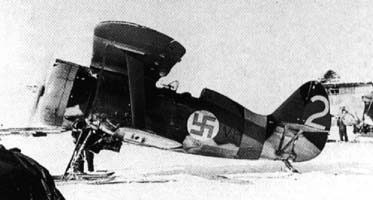
Finnish claims with I-153s:
| No. | Date | Type | Result | Pilot | Plane type | Serial no. | Locality | Unit |
| 1 | 26/06/41 | SB-2 | Destroyed | T. Hämelä | I-153 | VH-14 | Korpoo | 3/LLv 6 |
| 19/03/42 | MBR-2 | Shared destroyed on the ground | (a) | I-153s | off Kotka | 3/LLv 6 | ||
| 2 | 04/07/42 | I-16 | Destroyed | Per-Erik Ahonius | I-153 | IT-16 | Seiskari | 3/LeLv 6 |
| 3 | 04/07/42 | I-16 | Destroyed | Per-Erik Ahonius | I-153 | IT-16 | Seiskari | 3/LeLv 6 |
| 05/07/42 | I-16 | Damaged | Johannes Niemeier | I-153 | IT-12 | E Seiskari | 3/LeLv 6 | |
| 05/07/42 | Patrol motorboat | Shared destroyed on the water | (c) | I-153 | near Shepelevskiy lighthouse | 3/LeLv 6 | ||
| 4 | 04/10/42 | I-153 | Destroyed | Olavi Puro | I-153 | IT-18 | Lavansaari | 3/LeLv 6 |
| 12/11/42 | Pe-2 | Damaged | Olavi Puro | I-153 | IT-18 | Peninsaari | 3/LeLv 6 | |
| 5 | 29/07/44 | Airacobra (b) | Destroyed | V. Rinkineva | I-153 | IT-31 | Loimola | 1/TLeLv 16 |
Polikarpov I-153s in Finnish service:
| Serial number | Squadron use | Notes | Stored | Total flying time |
| VH-101 - VH-11 - IT-11 | 18/04/40 LLv 14 22/04/40 LLv 26 18/10/40 LLv 14 18/04/41 Er.LLv 21/06/41 3/LLv 6 27/03/43 1/LeLv 30 27/06/44 1/TleLv 16 03/09/44 3/HleLv 26 09/10/44 HLeLv 28 |
Winter War booty aircraft. 10/06/40 Renumbered to VH-11. 27/03/42 Crashed on the ice near Haapasaari in a snowstorm. The pilot vänrikki K. Salminen injured. 24/02/45 Crash-landed at Tampere after that the engine stalled. |
274,20 hours | |
| VH-12 - IT-12 | 13/01/41 LLv 14 10/04/41 Er.LLv 21/06/41 3/LLv 6 |
Winter War booty aircraft. 09/09/40 Hit a telephone pole and was damaged. The pilot vänrikki E. Halme was uninjured. 11/06/42 Renumbered to IT-12. 05/07/42 I-16 damaged by vänrikki Johannes Niemeier of LeLv 6 east of Seiskari. 09/07/42 Engine caught fire and after a forced landing near Someri Island the aircraft sank. The pilot kersantti S. Jänkävaara was injured. |
162,50 hours | |
| VH-13 - IT-13 | 18/04/41 Er.LLv 21/06/41 3/LLv 6 15/01/43 2/LeLv 30 |
Winter War booty aircraft. 14/10/40 Overturned after landing-gear failure. The pilot luutnantti E. Itävuori uninjured. 12/09/41 The left-hand wheel broke off and the aircraft overturned. The pilot K. Koskinen uninjured. 06/12/41 Returned to 3/LLv 6 after repairs. 24/02/42 Landing-gear failure led to a crash near Hamina. The pilot kapteeni E. Jauri uninjured. 24/03/43 Enginen hit by bullets in dogfight and the aircraft was forced to land on ice near Peninsaari. The pilot kersantti S. Jänkävaara escaped uninjured and was rescued on the ice by vänrikki Olavi Puro. The aircraft was shot alight by the rest of the patrol. |
101,05 hours | |
| VH-14 | 08/01/41 LLv 14 18/04/41 Er.LLv 21/06/41 3/LLv 6 |
Winter War booty aircraft. 26/06/41 SB-2 claimed by lentomestari T. Hämelä of LLv 6 at Korpoo. 10/07/41 Shot down by Soviet fighters in the Hanko area. The pilot luutnantti V. Kallio was killed. |
||
| VH-15 - IT-15 | 21/03/42 3/LLv 6 30/11/42 2/LeLv 6 ??/??/?? 1/HLeLv 30 26/06/44 1/TLeLv 26 03/09/44 3/HLeLv 26 09/10/44 HLeLv 28 |
Winter War booty aircraft. 25/03/42 Ran out of fuel and was damaged in the forced landing at Kotka Harbour. The pilot vänrikki Johannes Niemeier uninjured. |
24/02/45 | 208,30 hours |
| VH-16 - IT-16 | 13/03/41 LLv 14 10/04/41 Er.LLv 21/06/41 3/LLv 6 |
Winter War booty aircraft. 11/03/41 Overturned when landing in snow in Tampere. Kersantti O. Kajutti uninjured. 26/06/41 Overshot the landing in tail-wind in Turku. Undercarriage and lower wing damaged. The pilot kersantti S. Jänkävaara uninjured. 20/01/42 The landing gear was not locked which led to a crash in Tampere. The pilot lentomestari A. Siltavuori uninjured. 11/02/42 Delivered back to 3/LLv 6 after repairs. 04/07/42 2 I-16s claimed by kapteeni Per-Erik Ahonius of 3/LeLv 6 at Seiskari. 20/07/42 Crashed when curving tightly at Römpötti. The pilot vänrikki E. Salminen was killed. |
140,10 hours | |
| VH-17 - IT-17 | 25/09/40 LLv 12 19/07/41 3/LLv 6 |
Winter War booty aircraft. 17/10/40 Crash-landed at Utti due to engine failure. The pilot kapteeni A. Maunula was injured. 05/04/42 Overturned on landing due to ski failure. The pilot vänrikki Johannes Niemeier uninjured. 31/07/42 Delivered back to 3/LeLv 6 after repairs. 04/10/42 Shot down in air combat near Lavansaari. The pilot vääpeli Kaarlo Olavi Salminen drowned. |
119,15 hours | |
| VH-18 - IT-18 | 21/03/42 3/LLv 6 16/11/42 2/LeLv 30 21/04/43 1/LeLv 30 |
Winter War booty aircraft. 04/10/42 I-153 claimed by vänrikki Olavi Puro of LeLv 6 at Lavansaari. 12/11/42 Pe-2 damaged by vänrikki Olavi Puro of LeLv 6 at Peninsaari. 22/04/43 Bounced when landing at Römpötti and turned on its left side. The pilot kersantti M. Ollikkala was uninjured. 03/02/44 Delivered back to 1/LeLv 30 after repairs. 11/02/44 Ran out of fuel and crash-landed in Nastola. The pilot vänrikki R. Hyvärinen was injured. The aircraft was not repaired. |
239,35 hours | |
| VH-19 - IT-19 | 31/07/41 3/LLv 6 16/11/42 2/LeLv 30 03/01/44 1/LeLv 30 25/06/44 1/TLeLv 16 03/09/44 3/HLeLv 26 09/10/44 HLeLv 28 |
25/06/41 Captured in Kerimäki. 24/10/41 Hit in a dogfight and hit a barn in the subsequent forced landing in Inkoo and was damaged. The pilot alikersantti K. Koskinen was uninjured. 10/09/42 Delivered back to 3/LeLv 6 after repairs. 10/12/42 Stalled when landing in Römpötti and overturned. The pilot luutnantti T. Kallio uninjured. 17/05/43 Damaged by fighters (probably Finnish Bf 109s) over eastern Gulf of Finland but returned safely to base. |
24/02/45 | 112,55 hours |
| IT-20 | 23/07/42 3/LeLv 6 16/11/42 2/LeLv 6 |
03/10/41 Captured in Sommarö. 08/01/43 Forced to land on ice near Tiurinsaari due to engine failure and shot through the ice. The pilot luutnantti Riemu Rauha Paltila drowned. |
100,40 hours | |
| IT-21 | 07/10/42 3/LeLv 6 16/12/43 2/LeLv 30 |
Continuation War booty aircraft. 22/11/41 Delivered to Depot. 28/10/42 Forced landing and overturned at Muutila due to engine failure. The pilot kersantti K. Koskinen injured. 22/12/43 Landed on soft soil and overturned at Vesivehmaa. The pilot kersantti M. Durchman uninjured. The aircraft was not repaired. |
25,10 hours | |
| IT-22 | 16/04/43 1/LeLv 30 | Nr. 6454 07/12/42 Delivered in Vienna. 29/12/42 Delivered to State Aircraft Factory. 20/04/43 Crashed as Römpötti. The pilot kersantti N. Alho injured. |
18,40 hours | |
| IT-23 | 13/07/43 1/LeLv 30 26/06/44 1/TLeLv 16 |
Nr. 6514 07/12/42 Delivered in Vienna. 29/12/42 Delivered to State Aircraft Factory. 04/07/44 Overturned at landing at Värtsilä. The pilot luutnantti E. Salo uninjured. The aircraft was not repaired. |
73,25 hours | |
| IT-24 | ??/??/4? 2/LeLv 30 26/06/44 1/TLeLv 16 31/08/44 3/HLeLv 26 09/10/44 HLeLv 28 |
Nr. 6627 07/12/42 Delivered in Vienna. 08/12/42 Nose-dived when taxiing into a dugout at Olmütz. The pilot vänrikki T. Mattila was unhurt. 13/03/43 Delivered to State Aircraft Factory. |
24/02/45 | 57,15 hours |
| IT-25 | 07/07/43 2/LeLv 30 26/06/44 1/TLeLv 16 03/09/44 3/HLeLv 26 09/10/44 HLeLv 28 |
Nr. 7046 07/12/42 Delivered in Vienna. 08/01/43 Delivered to State Aircraft Factory. 06/09/43 Stalled at landing and lower left wing was damaged. 23/08/44 Bounced on landing and overturned at Värtsilä. The pilot Lieutenant-Colonel O. Holm uninjured. |
24/02/45 | 97,10 hours |
| IT-26 | 02/05/43 1/LeLv 30 | Nr. 7058 07/12/42 Delivered in Vienna. 29/12/42 Delivered to State Aircraft Factory. 02/05/43 Force-landed at Vesivehmaa but hit trees before landing and damaged lower right-hand wing. The pilot vänrikki A. Hujanen uninjured. Repaired in a week and returned to the unit. 17/03/44 Overturned in deep snow when landing at Vesivehmaa. The pilot vänrikki L. Linden was injured. The aircraft was not repaired. |
78,10 hours | |
| IT-27 | 17/04/43 2/LeLv 30 27/06/44 1/TLeLv 16 09/10/44 3/HLeLv 28 |
Nr. 7141 07/12/42 Delivered in Vienna. 29/12/42 Delivered to State Aircraft Factory. 15/07/43 Damaged by LaGG-3 during reconnaissance flight. |
24/02/45 | 147,00 hours |
| IT-28 | Nr. 8161 07/12/42 Delivered in Vienna. 29/12/42 Delivered to State Aircraft Factory. ??/??/4? Forced landing into a forest at Sippola due to fuel feeding troubles. The pilot vänrikki T. Mattila uninjured. |
20/06/43 | 14,15 hours | |
| IT-29 | 19/04/43 2/LeLv 30 | Nr. 8232 07/12/42 Delivered in Vienna. 29/12/42 Delivered to State Aircraft Factory. ??/??/4? Overturned when landing on soft soil at Römpötti. The pilot luutnantti O. Lilja uninjured. 05/08/43 Disappeared near Peninsaari. The pilot luutnantti M. Hurttila missing. |
59,10 hours | |
| IT-30 | 20/04/43 1/LeLv 30 25/06/44 1/TLeLv 16 03/09/44 3/HLeLv 26 09/10/44 HLeLv 28 |
Nr. 8245 07/12/42 Delivered in Vienna. 29/12/42 Delivered to State Aircraft Factory. 06/09/43 Overturned in loose sand when taking off at Römpötti. The pilot vänrikki M. Halme uninjured. 03/07/44 Crash-landed after landing gear failure at Värtsilä. The pilot luutnantti E. Salo uninjured. |
24/02/45 | 116,10 hours |
| IT-31 | 03/01/44 2/LeLv 30 25/06/44 1/TLeLv 16 03/09/44 3/HLeLv 26 09/10/44 HLeLv 28 |
Nr. 8252 Transfer sign H4+MB. 27/08/43 Delivered in Hildesheim. 20/09/43 Delivered to State Aircraft Factory. 29/07/44 Airacobra claimed by kersantti V. Rinkineva of 1/LeLv 16 at Loimola. |
23/02/45 | 71,05 hours |
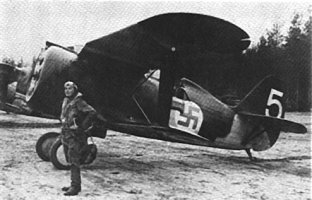
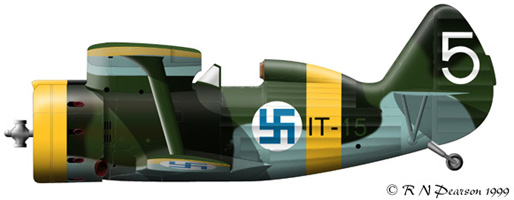
Sources:
All aces of Stalin 1936–1953 – Mikhail Bykov, 2014
Finnish Air Force 1939-1945 - Kalevi Keskinen and Kari Stenman, 1998
Ilmavoitot, osa 1 - Kalevi Keskinen and Kari Stenman, ISBN 952-99432-8-8
Ilmavoitot, osa 2 - Kalevi Keskinen and Kari Stenman, ISBN 952-99432-8-8
LeR 2 - Kalevi Keskinen and Kari Stenman, 2001, ISBN 951-98751-0-7
Polikarpov Fighters in action Pt. 1 - Hans-Heiri Stapfer, 1995
‘Pollies’ in Finland – Kari Stenman, 2005 Air Enthusiast November/December 2005 No. 120
Soviet Aces 1936-1953
Sovietskije bombardirowki Finlandii w ijunie 1941 goda - Carl-Fredrik Geust, 2005 Aviacja i Vremia 2/2005 kindly provided by Mirek Wawrzynski
Stalin's Falcons - Tomas Polak and Christhoper Shores, 1999 Grub Street, London, ISBN 1-902304-01-2
Suomen Ilmavoimat part III – 1941 – Kalevi Keskinen and Kari Stenman, 2007, ISBN 978-952-99743-1-3
Suomen Ilmavoimat part IV – 1942 – Kalevi Keskinen and Kari Stenman, 2007, ISBN 978-952-99743-2-0
Venäläiset Hävittäjät - Kalevi Keskinen, Kari Stenman and Klaus Niska, ISBN 951-9035-25-7
Additional image and information kindly provided by Johan Löfling.
Additional information kindly provided by Juha Paltila and Mirek Wawrzynski.


